light YAMAHA YZF-R6 2001 User Guide
[x] Cancel search | Manufacturer: YAMAHA, Model Year: 2001, Model line: YZF-R6, Model: YAMAHA YZF-R6 2001Pages: 118, PDF Size: 12.83 MB
Page 48 of 118

OPERATION AND IMPORTANT RIDING POINTS
5-3
5
EAU00423
Shifting Shifting gears lets you control the
amount of engine power available for
starting off, accelerating, climbing hills,
etc.
The gear positions are shown in the
illustration.NOTE:@ To shift the transmission into the neu-
tral position, press the shift pedal down
repeatedly until it reaches the end of its
travel, and then slightly raise it. @
EC000048
CAUTION:@ l
Even with the transmission in
the neutral position, do not
coast for long periods of time
with the engine off, and do not
tow the motorcycle for long dis-
tances. The transmission is
properly lubricated only when
the engine is running. Inade-
quate lubrication may damage
the transmission.
l
Always use the clutch while
changing gears to avoid dam-
aging the engine, transmission,
and drive train, which are not
designed to withstand the
shock of forced shifting.
@
EAU00424
Tips for reducing fuel
consumption Fuel consumption depends largely on
your riding style. Consider the following
tips to reduce fuel consumption:l
Thoroughly warm up the engine.
l
Turn the starter (choke) off as
soon as possible.
l
Shift up swiftly, and avoid high en-
gine speeds during acceleration.
l
Do not rev the engine while shift-
ing down, and avoid high engine
speeds with no load on the engine.
l
Turn the engine off instead of let-
ting it idle for an extended length
of time (e.g., in traffic jams, at traf-
fic lights or at railroad crossings).
1. Shift pedal
N. Neutral positionE_5mt.book Page 3 Monday, September 18, 2000 9:08 AM
Page 51 of 118
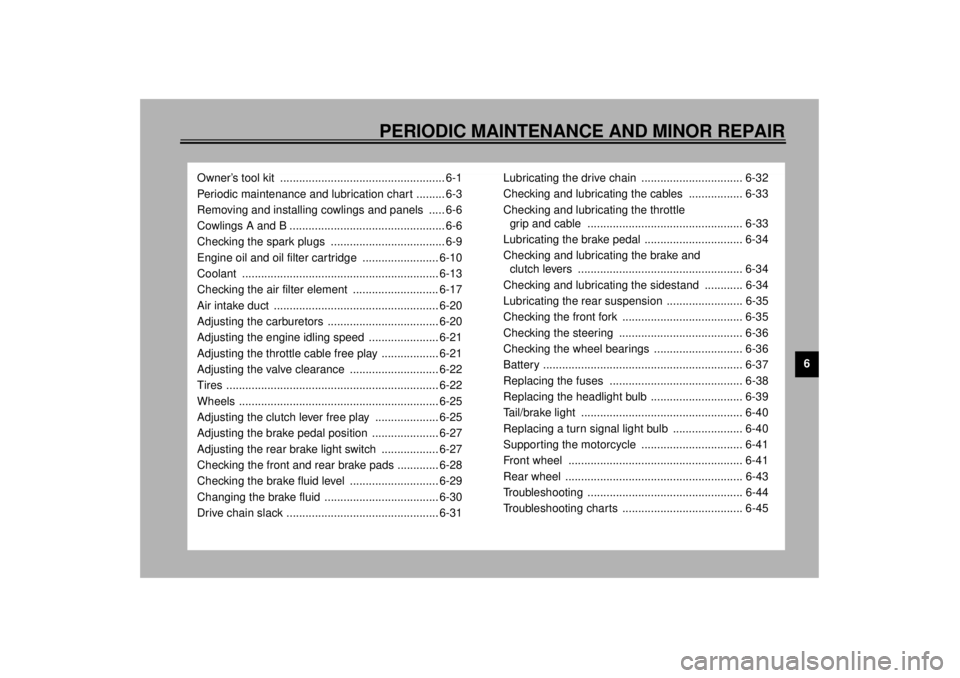
6
PERIODIC MAINTENANCE AND MINOR REPAIR
Owner’s tool kit .................................................... 6-1
Periodic maintenance and lubrication chart ......... 6-3
Removing and installing cowlings and panels ..... 6-6
Cowlings A and B ................................................. 6-6
Checking the spark plugs .................................... 6-9
Engine oil and oil filter cartridge ........................ 6-10
Coolant .............................................................. 6-13
Checking the air filter element ........................... 6-17
Air intake duct .................................................... 6-20
Adjusting the carburetors ................................... 6-20
Adjusting the engine idling speed ...................... 6-21
Adjusting the throttle cable free play .................. 6-21
Adjusting the valve clearance ............................ 6-22
Tires ................................................................... 6-22
Wheels ............................................................... 6-25
Adjusting the clutch lever free play .................... 6-25
Adjusting the brake pedal position ..................... 6-27
Adjusting the rear brake light switch .................. 6-27
Checking the front and rear brake pads ............. 6-28
Checking the brake fluid level ............................ 6-29
Changing the brake fluid .................................... 6-30
Drive chain slack ................................................ 6-31Lubricating the drive chain ................................ 6-32
Checking and lubricating the cables ................. 6-33
Checking and lubricating the throttle
grip and cable ................................................. 6-33
Lubricating the brake pedal ............................... 6-34
Checking and lubricating the brake and
clutch levers .................................................... 6-34
Checking and lubricating the sidestand ............ 6-34
Lubricating the rear suspension ........................ 6-35
Checking the front fork ...................................... 6-35
Checking the steering ....................................... 6-36
Checking the wheel bearings ............................ 6-36
Battery ............................................................... 6-37
Replacing the fuses .......................................... 6-38
Replacing the headlight bulb ............................. 6-39
Tail/brake light ................................................... 6-40
Replacing a turn signal light bulb ...................... 6-40
Supporting the motorcycle ................................ 6-41
Front wheel ....................................................... 6-41
Rear wheel ........................................................ 6-43
Troubleshooting ................................................. 6-44
Troubleshooting charts ...................................... 6-45
E_5mt.book Page 1 Monday, September 18, 2000 9:08 AM
Page 56 of 118
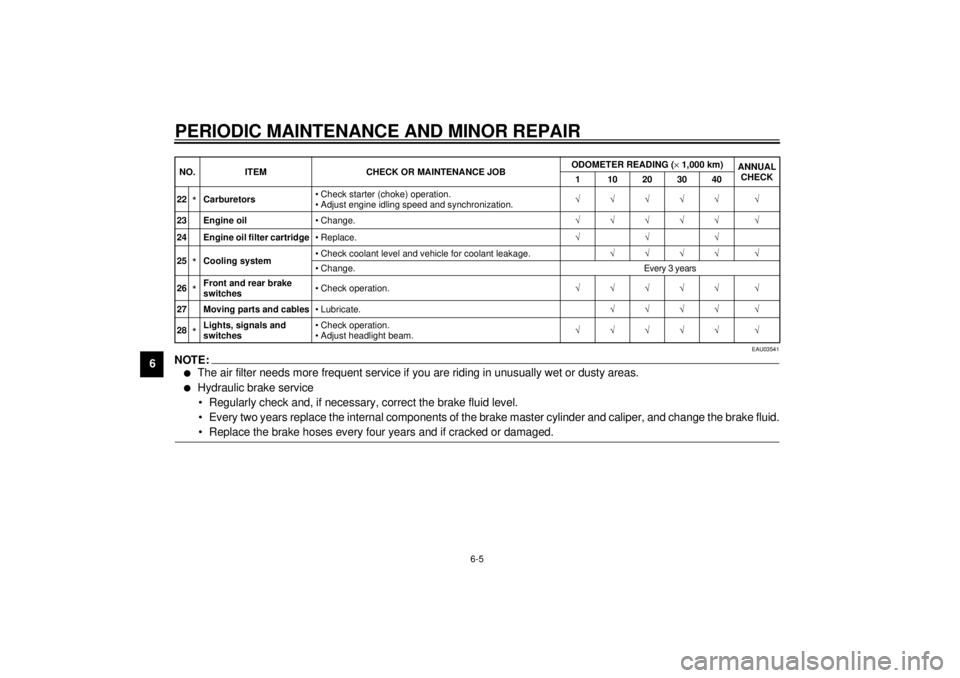
PERIODIC MAINTENANCE AND MINOR REPAIR
6-5
6
EAU03541
NOTE:@l
The air filter needs more frequent service if you are riding in unusually wet or dusty areas.
l
Hydraulic brake service
• Regularly check and, if necessary, correct the brake fluid level.
• Every two years replace the internal components of the brake master cylinder and caliper, and change the brake fluid.
• Replace the brake hoses every four years and if cracked or damaged.
@22
*Carburetors• Check starter (choke) operation.
• Adjust engine idling speed and synchronization.ÖÖÖÖÖ Ö
23 Engine oil• Change.ÖÖÖÖÖ Ö
24 Engine oil filter cartridge•Replace.ÖÖÖ
25*Cooling system• Check coolant level and vehicle for coolant leakage.ÖÖÖÖ Ö
• Change. Every 3 years
26*Front and rear brake
switches• Check operation.ÖÖÖÖÖ Ö
27 Moving parts and cables• Lubricate.ÖÖÖÖ Ö
28*Lights, signals and
switches• Check operation.
• Adjust headlight beam.ÖÖÖÖÖ Ö NO. ITEM CHECK OR MAINTENANCE JOBODOMETER READING (´1,000 km)
ANNUAL
CHECK
1 10203040
E_5mt_Periodic.fm Page 5 Tuesday, December 12, 2000 5:49 PM
Page 60 of 118

PERIODIC MAINTENANCE AND MINOR REPAIR
6-9
6
EAU01639
Checking the spark plugs The spark plugs are important engine
components, which should be checked
periodically, preferably by a Yamaha
dealer. Since heat and deposits will
cause any spark plug to slowly erode,
they should be removed and checked
in accordance with the periodic mainte-
nance and lubrication chart. In addition,
the condition of the spark plugs can re-
veal the condition of the engine.The porcelain insulator around the cen-
ter electrode of each spark plug should
be a medium-to-light tan (the ideal col-
or when the motorcycle is ridden nor-
mally), and all spark plugs installed in
the engine should have the same color.
If any spark plug shows a distinctly dif-
ferent color, the engine could be defec-
tive. Do not attempt to diagnose such
problems yourself. Instead, have a
Yamaha dealer check the motorcycle.
If a spark plug shows signs of electrode
erosion and excessive carbon or other
deposits, it should be replaced.
Before installing a spark plug, the spark
plug gap should be measured with a
wire thickness gauge and, if necessary,
adjusted to specification.Clean the surface of the spark plug
gasket and its mating surface, and then
wipe off any grime from the spark plug
threads.
NOTE:@ If a torque wrench is not available when
installing a spark plug, a good estimate
of the correct torque is 1/4–1/2 turn
past finger tight. However, the spark
plug should be tightened to the speci-
fied torque as soon as possible. @
a. Spark plug gap
Specified spark plug:
CR10EK (NGK)
Spark plug gap:
0.6–0.7 mm
Tightening torque:
Spark plug:
12.5 Nm (1.25 m·kg)
E_5mt.book Page 9 Monday, September 18, 2000 9:08 AM
Page 61 of 118
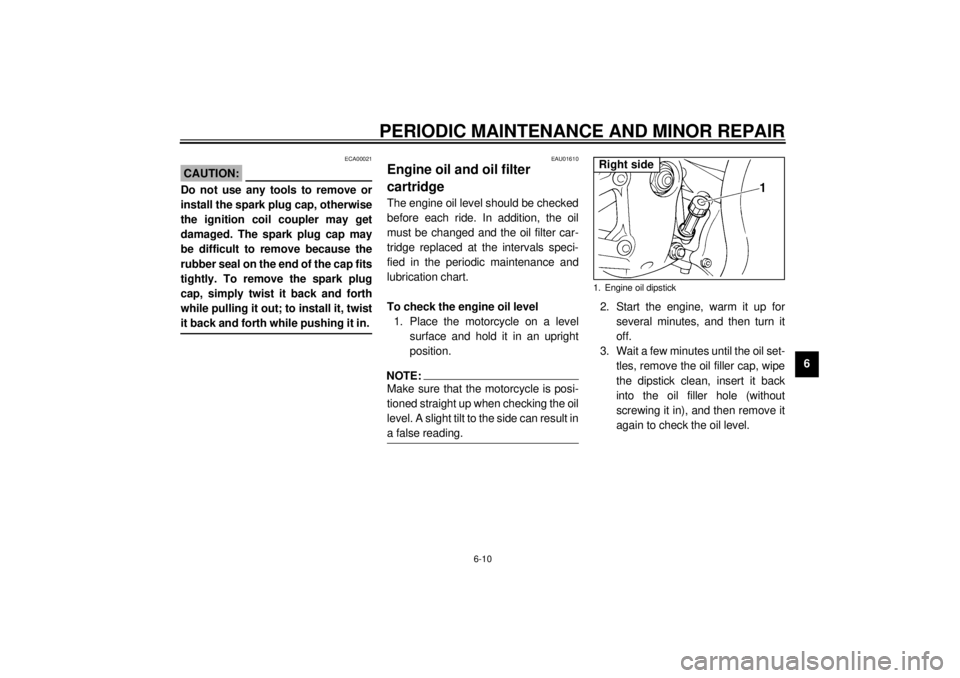
PERIODIC MAINTENANCE AND MINOR REPAIR
6-10
6
ECA00021
CAUTION:@ Do not use any tools to remove or
install the spark plug cap, otherwise
the ignition coil coupler may get
damaged. The spark plug cap may
be difficult to remove because the
rubber seal on the end of the cap fits
tightly. To remove the spark plug
cap, simply twist it back and forth
while pulling it out; to install it, twist
it back and forth while pushing it in. @
EAU01610
Engine oil and oil filter
cartridge The engine oil level should be checked
before each ride. In addition, the oil
must be changed and the oil filter car-
tridge replaced at the intervals speci-
fied in the periodic maintenance and
lubrication chart.
To check the engine oil level
1. Place the motorcycle on a level
surface and hold it in an upright
position.NOTE:@ Make sure that the motorcycle is posi-
tioned straight up when checking the oil
level. A slight tilt to the side can result in
a false reading. @
2. Start the engine, warm it up for
several minutes, and then turn it
off.
3. Wait a few minutes until the oil set-
tles, remove the oil filler cap, wipe
the dipstick clean, insert it back
into the oil filler hole (without
screwing it in), and then remove it
again to check the oil level.1. Engine oil dipstickRight side
E_5mt.book Page 10 Monday, September 18, 2000 9:08 AM
Page 64 of 118
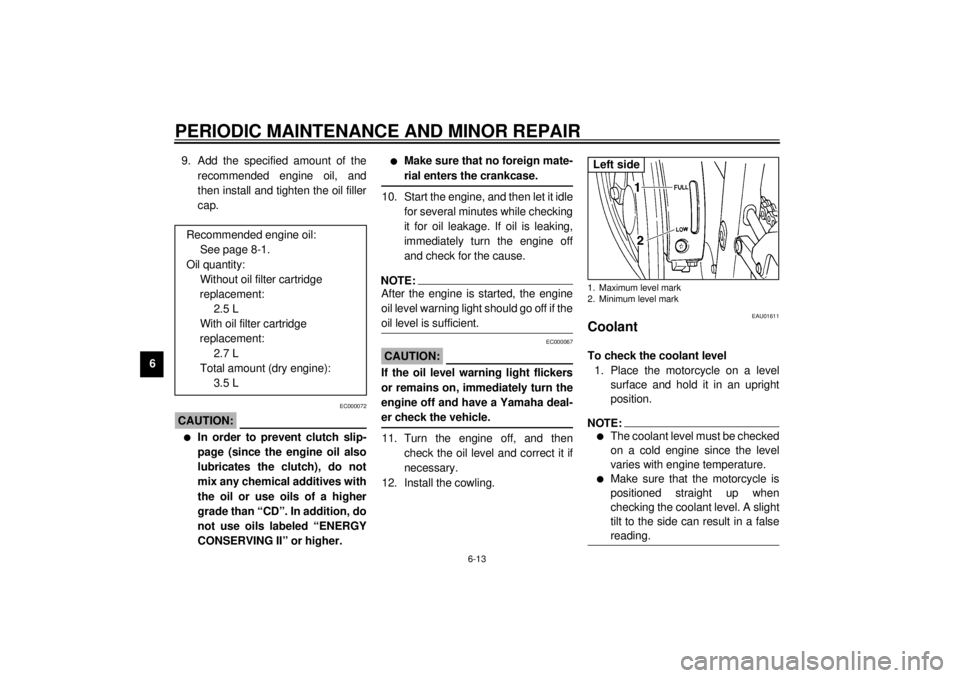
PERIODIC MAINTENANCE AND MINOR REPAIR
6-13
69. Add the specified amount of the
recommended engine oil, and
then install and tighten the oil filler
cap.
EC000072
CAUTION:@ l
In order to prevent clutch slip-
page (since the engine oil also
lubricates the clutch), do not
mix any chemical additives with
the oil or use oils of a higher
grade than “CD”. In addition, do
not use oils labeled “ENERGY
CONSERVING II” or higher.
l
Make sure that no foreign mate-
rial enters the crankcase.
@10. Start the engine, and then let it idle
for several minutes while checking
it for oil leakage. If oil is leaking,
immediately turn the engine off
and check for the cause.NOTE:@ After the engine is started, the engine
oil level warning light should go off if the
oil level is sufficient. @
EC000067
CAUTION:@ If the oil level warning light flickers
or remains on, immediately turn the
engine off and have a Yamaha deal-
er check the vehicle. @11. Turn the engine off, and then
check the oil level and correct it if
necessary.
12. Install the cowling.
EAU01611
Coolant To check the coolant level
1. Place the motorcycle on a level
surface and hold it in an upright
position.NOTE:@ l
The coolant level must be checked
on a cold engine since the level
varies with engine temperature.
l
Make sure that the motorcycle is
positioned straight up when
checking the coolant level. A slight
tilt to the side can result in a false
reading.
@
Recommended engine oil:
See page 8-1.
Oil quantity:
Without oil filter cartridge
replacement:
2.5 L
With oil filter cartridge
replacement:
2.7 L
Total amount (dry engine):
3.5 L
1. Maximum level mark
2. Minimum level markLeft side
E_5mt.book Page 13 Monday, September 18, 2000 9:08 AM
Page 78 of 118

PERIODIC MAINTENANCE AND MINOR REPAIR
6-27
6
EAU01357
Adjusting the brake pedal
position The top of the brake pedal should be
positioned approximately 7–11 mm be-
low the bottom of the footrest bracket
as shown. Periodically check the brake
pedal position and, if necessary, have
a Yamaha dealer adjust it.
EW000109
WARNING
_ A soft or spongy feeling in the brake
pedal can indicate the presence of
air in the hydraulic system. If there
is air in the hydraulic system, have a
Yamaha dealer bleed the system be-
fore operating the motorcycle. Air in
the hydraulic system will diminish
the braking performance, which
may result in loss of control and an
accident. _
EAU00713
Adjusting the rear brake light
switch The rear brake light switch, which is ac-
tivated by the brake pedal, is properly
adjusted when the brake light comes
on just before braking takes effect. If
necessary, adjust the brake light switch
as follows.
Turn the adjusting nut while holding the
rear brake light switch in place. To
make the brake light come on earlier,
turn the adjusting nut in direction
a. To
make the brake light come on later,
turn the adjusting nut in direction
b.
a. Distance between brake pedal and footrest
bracket
1. Rear brake light switch
2. Rear brake light switch adjusting nut
E_5mt_Periodic.fm Page 27 Tuesday, December 12, 2000 5:49 PM
Page 89 of 118

PERIODIC MAINTENANCE AND MINOR REPAIR
6-38
6
EC000102
CAUTION:@ l
Always keep the battery
charged. Storing a discharged
battery can cause permanent
battery damage.
l
To charge a sealed-type (MF)
battery, a special (constant-
voltage) battery charger is re-
quired. Using a conventional
battery charger will damage the
battery. If you do not have ac-
cess to a sealed-type (MF) bat-
tery charger, have a Yamaha
dealer charge your battery.
@
EAU01754
Replacing the fuses The fuse box is located under the rider
seat. (See page 3-13 for rider seat re-
moval and installation procedures.)
If a fuse is blown, replace it as follows.
1. Turn the key to “OFF” and turn off
the electrical circuit in question.
2. Remove the blown fuse, and then
install a new fuse of the specified
amperage.1. Headlight fuse
2. Radiator fan fuse
3. Ignition fuse
4. Signaling system fuse
5. Odometer fuse
6. Spare fuse (´ 3)
1. Main fuse
2. Spare main fuseSpecified fuses:
Main fuse: 30 A
Headlight fuse: 20 A
Signaling system fuse: 15 A
Radiator fan fuse: 7.5 A
Ignition fuse: 15 A
Odometer fuse: 7.5 A
E_5mt.book Page 38 Monday, September 18, 2000 9:08 AM
Page 90 of 118

PERIODIC MAINTENANCE AND MINOR REPAIR
6-39
6
EC000103
CAUTION:@ Do not use a fuse of a higher amper-
age rating than recommended to
avoid causing extensive damage to
the electrical system and possibly a
fire. @3. Turn the key to “ON” and turn on
the electrical circuit in question to
check if the device operates.
4. If the fuse immediately blows
again, have a Yamaha dealer
check the electrical system.
EAU01822
Replacing the headlight bulb This motorcycle is equipped with a
quartz bulb headlight. If the headlight
bulb burns out, replace it as follows.
1. Remove panel C. (See page 6-8
for panel removal and installation
procedures.)
2. Disconnect the headlight coupler,
and then remove the headlight
bulb cover.3. Unhook the headlight bulb holder,
and then remove the defective
bulb.
EW000119
WARNING
@ Headlight bulbs get very hot. There-
fore, keep flammable products away
from a lit headlight bulb, and do not
touch the bulb until it has cooled
down. @4. Place a new bulb into position, and
then secure it with the bulb holder.
1. Headlight coupler
2. Headlight bulb cover
1. Headlight bulb holder
E_5mt.book Page 39 Monday, September 18, 2000 9:08 AM
Page 91 of 118
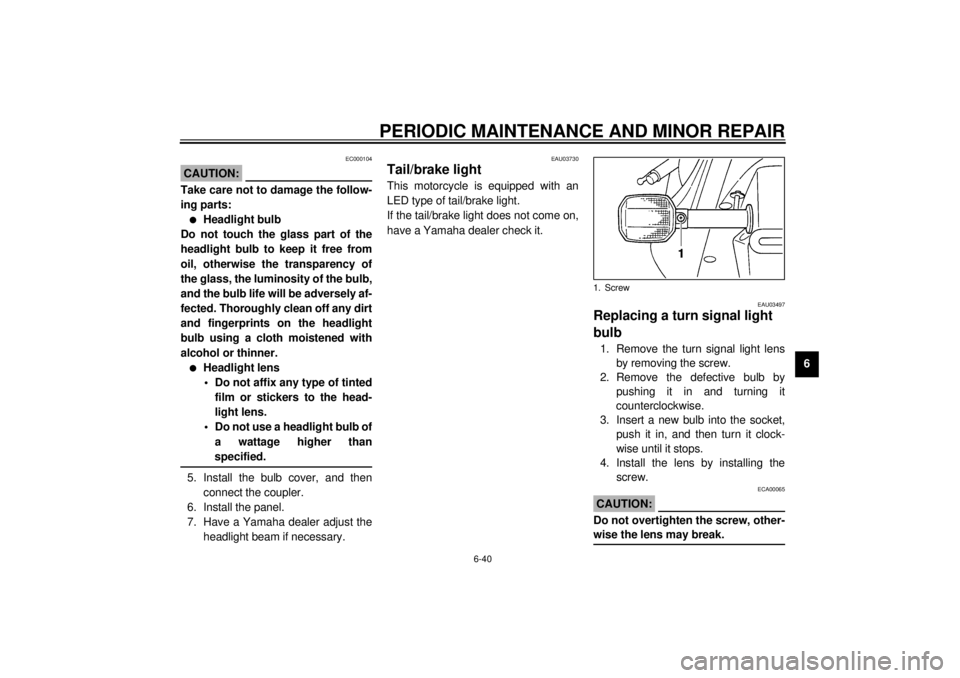
PERIODIC MAINTENANCE AND MINOR REPAIR
6-40
6
EC000104
CAUTION:@ Take care not to damage the follow-
ing parts:l
Headlight bulb
Do not touch the glass part of the
headlight bulb to keep it free from
oil, otherwise the transparency of
the glass, the luminosity of the bulb,
and the bulb life will be adversely af-
fected. Thoroughly clean off any dirt
and fingerprints on the headlight
bulb using a cloth moistened with
alcohol or thinner.
l
Headlight lens
• Do not affix any type of tinted
film or stickers to the head-
light lens.
• Do not use a headlight bulb of
a wattage higher than
specified.
@5. Install the bulb cover, and then
connect the coupler.
6. Install the panel.
7. Have a Yamaha dealer adjust the
headlight beam if necessary.
EAU03730
Tail/brake light This motorcycle is equipped with an
LED type of tail/brake light.
If the tail/brake light does not come on,
have a Yamaha dealer check it.
EAU03497
Replacing a turn signal light
bulb 1. Remove the turn signal light lens
by removing the screw.
2. Remove the defective bulb by
pushing it in and turning it
counterclockwise.
3. Insert a new bulb into the socket,
push it in, and then turn it clock-
wise until it stops.
4. Install the lens by installing the
screw.
ECA00065
CAUTION:@ Do not overtighten the screw, other-
wise the lens may break. @1. Screw
E_5mt.book Page 40 Monday, September 18, 2000 9:08 AM